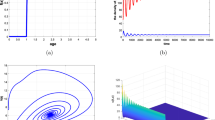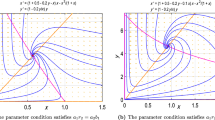Abstract
Loladze et al. (Bull Math Biol 62:1137–1162, 2000) proposed a highly cited stoichiometric predator–prey system, which is nonsmooth, and thus it is extremely difficult to analyze its global dynamics. The main challenge comes from the phase plane fragmentation and parameter space partitioning in order to perform a detailed and complete global stability and bifurcation analysis. Li et al. (J Math Biol 63:901–932, 2011) firstly discussed its global dynamical behavior with Holling type I functional response and found that the system has no limit cycles, and the internal equilibrium is globally asymptotically stable if it exists. Secondly, for the system with Holling type II functional response, Li et al. (2011) fixed all parameters (with realistic values) except K to perform the bifurcation analysis and obtained some interesting phenomena, for instance, the appearance of bistability and many bifurcation types. The aim of this paper is to provide a complete global analysis for the system with Holling type II functional response without fixing any parameter. Our analysis shows that the model has far richer dynamics than those found in the previous paper (Li et al. 2011), for example, four types of bistability appear: besides the bistability between an internal equilibrium and a limit cycle as shown in Li et al. (2011), the other three bistabilities occur between an internal equilibrium and a boundary equilibrium, between two internal equilibria, or between a boundary equilibrium and a limit cycle. In addition, this paper rigorously provides all possible bifurcation passways of this stoichiometric model with Holling type II functional response.












Similar content being viewed by others
References
Andersen, T.: Pelagic Nutrient Cycles: Herbivores as Sourced and Sinks for Nutrients. Springer-Verlag, Berlin (1997)
Cheng, K.S.: Uniqueness of a limit cycle for a predator-prey system. SIAM. J. Math. Anal. 12, 541–548 (1981)
Everett, R.A., Nagy, J.D., Kuang, Y.: Dynamics of a data based ovarian cancer growth and treatment model with time delay. J. Dyn. Diff. Equ. 28, 1393–1414 (2016)
Grover, J.: Stoichiometry, herbivory and competition for nutrients: simple models based on planktonic ecosystems. J. Theor. Biol. 214, 599–618 (2002)
Hessen, D.O., Bjerkeng, B.: A model approach to planktonic stoichiometry and consumer-resource stability. Freshw. Biol. 38, 447–471 (1997)
Hsu, S.B., Hubbell, S.P., Waltman, P.: Competing predators. SIAM J. Appl. Math. 35, 617–625 (1978)
Kuang, Y., Huisman, J., Elser, J.J.: Stoichiometric plant-herbivore models and their interpretation. Math. Biosci. Eng. 1, 215–222 (2004)
Kuang, Y., Nagy, J.D., Elser, J.J.: Biological stoichiometry of tumor dynamics: mathematical models and analysis. Disc. Cont. Dyn. Sys. Ser. B 4, 221–240 (2004)
Kuang, Y., Nagy, J.D., Eikenberry, S.E.: Introduction to Mathematical Oncology. Chapman and Hall/CRC, Boca Raton (2016)
Li, X., Wang, H., Kuang, Y.: Global analysis of a stoichiometric producer-grazer model with Holling type functional responses. J. Math. Biol. 63, 901–932 (2011)
Loladze, I., Kuang, Y., Elser, J.J.: Stoichiometry in producer-grazer systems: linking energy flow with element cycling. Bull. Math. Biol. 62, 1137–1162 (2000)
Lotka, A.: Elements of Physical Biology. Williams & Wilkins, Baltimore, MD (1925)
Peace, A.: Effects of light, nutrients, and food chain length on trophic efficiencies in simple stoichiometric aquatic food chain models. Ecol. Modell. 312, 125–135 (2015)
Peace, A., Zhao, Y., Loladze, I., Elser, J.J., Kuang, Y.: A stoichiometric producer-grazer model incorporating the effects of excess food-nutrient content on consumer dynamics. Math. Biosci. 244, 107–115 (2013)
Peace, A., Wang, H., Kuang, Y.: Dynamics of a producer-grazer model incorporating the effects of excess food-nutrient content on grazer’s growth. Bull. Math. Biol. 76, 2175–2197 (2014)
Volterra, V.: Fluctuations in the abundance of a species considered mathematically. Nature 118, 558–600 (1926)
Wang, H., Smith, H.L., Kuang, Y., Elser, J.J.: Dynamics of stoichiometric bacteria-algae interactions in the epilimnion. SIAM J. Appl. Math. 68, 503–522 (2007)
Wang, H., Kuang, Y., Loladze, I.: Dynamics of a mechanistically derived stoichiometric producer-grazer model. J. Biol. Dyn. 2, 286–296 (2008)
Wang, H., Sterner, R.W., Elser, J.J.: On the “strict homeostasis” assumption in ecological stoichiometry. Ecol. Modell. 243, 81–88 (2012)
Acknowledgments
The third author is partially supported by the NSFC (11571041) and the Fundamental Research Funds for the Central Universities. The fourth author is partially supported by the NSERC.
Author information
Authors and Affiliations
Corresponding author
Rights and permissions
About this article
Cite this article
Xie, T., Yang, X., Li, X. et al. Complete Global and Bifurcation Analysis of a Stoichiometric Predator–Prey Model. J Dyn Diff Equat 30, 447–472 (2018). https://doi.org/10.1007/s10884-016-9551-5
Received:
Revised:
Published:
Issue Date:
DOI: https://doi.org/10.1007/s10884-016-9551-5




